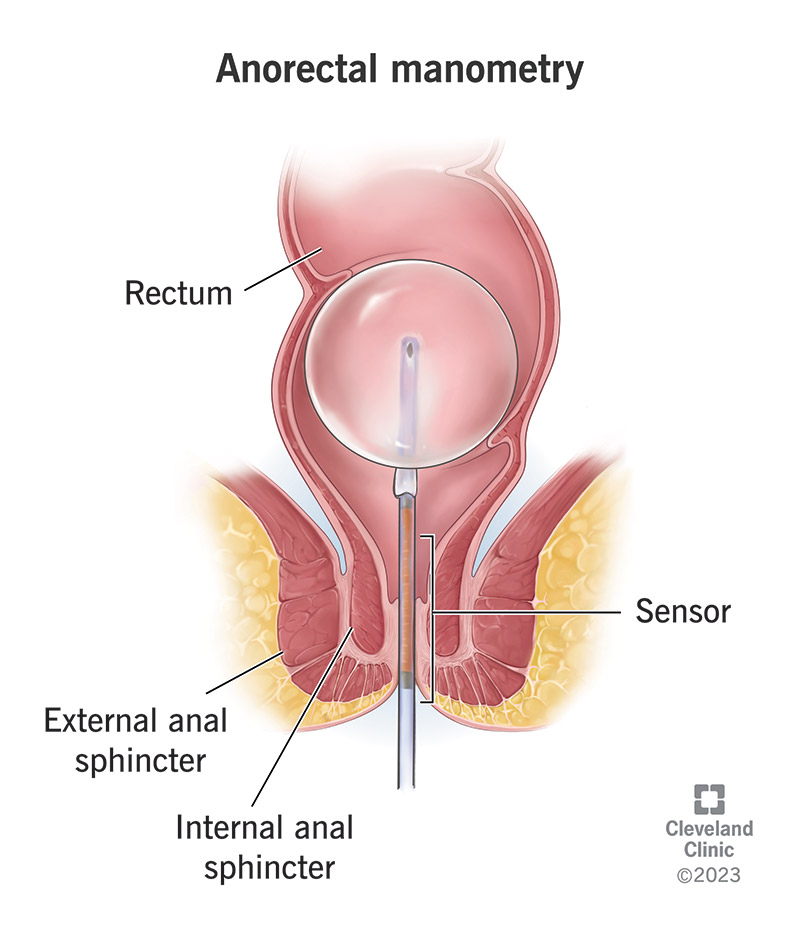An anorectal manometry is a study of the muscles that coordinate together to produce a bowel movement. If you’ve been having difficulties activating these muscles, this test can help your healthcare provider find the source of the issue.
Advertisement
Cleveland Clinic is a non-profit academic medical center. Advertising on our site helps support our mission. We do not endorse non-Cleveland Clinic products or services. Policy

Anorectal manometry is a test to evaluate your anal and rectal muscles. These muscles work together with your brain to control your bowel movements. If you’ve been having difficulties with bowel movements, it could be related to how these muscles function. Anorectal manometry is a way of measuring your muscle contractions to determine if they’re activating and coordinating correctly.
Advertisement
Cleveland Clinic is a non-profit academic medical center. Advertising on our site helps support our mission. We do not endorse non-Cleveland Clinic products or services. Policy
A healthcare provider might recommend an anorectal manometry test if you've been having trouble pooping when and where you want to. It’s one step in the process of evaluating symptoms like:
A healthcare provider may also use the test to evaluate your muscle function after an injury or surgery, or to check whether a chronic disease has begun to affect your anorectal motility (motor function).
Anorectal manometry can help diagnose conditions that may explain your constipation, such as:
It can also explain the origin of fecal incontinence — what’s going wrong and where. After diagnosis, the same technology used in the test can be used as a treatment to retrain the muscles involved.
A manometer is a pressure transducer. It measures the pressure in your muscle contractions to determine whether they’re too strong, too weak or not triggering at the right time. A healthcare provider places the transducer inside your anus and rectum. It sends data to a machine that reads it.
Advertisement
The transducer is a long, flexible tube (catheter) with pressure sensors on it. On the inside end, it’s attached to a deflated balloon. When a healthcare provider inflates the balloon inside your rectum, it activates the nerves that trigger the urge to poop. This should stimulate your natural muscle reflexes.
It’s best that your anus and rectum are empty for the test. Your healthcare provider will ask you to refrain from eating before the test and to use an enema to clear out your anus and rectum at home. They’ll give you specific instructions on when and how to do this, and advice on which products to use.
It takes an average of 30 minutes. It may range from 15 to 45 minutes.
You might find it mildly uncomfortable, particularly if you’re sore inside your rectum or anus, but it shouldn’t be painful. The catheter and the balloon only produce as much pressure as a normal poop would. If you’re anxious about it, though, you can discuss sedation with your healthcare provider.
Your healthcare provider may combine anorectal manometry with a balloon expulsion test at the end. This is an extra step to see if you can “poop” out a filled balloon, and how long it takes you. You’ll do this part in privacy, in a sitting position. Sensors on the balloon will record the pressure and time involved.
There aren’t any significant risks or side effects unless you have an allergy to the latex balloon. Your healthcare provider can provide a latex-free option if you discuss this with them in advance. If your anus or rectum was inflamed or irritated, you might feel a little sore or have mild bleeding afterward.
The results will show whether the muscles and nerves involved in pooping are functioning correctly, and where the problem is if they aren’t. Normal results will show:
Advertisement
If any of these functions don’t work as they should, you might have an abnormal test result. Abnormal results might show:
Yes. Once your healthcare provider is able to determine which muscles are malfunctioning and how, they can employ different techniques to help retrain the muscles. Typical therapies include:
Anorectal manometry is a brief and painless test that can give your healthcare provider crucial information about how your anorectal muscles are functioning. You might feel reluctant to use your pooping muscles in a medical exam, but if you’re having pooping difficulties, it’s worth it to find out why. Once you do, you can begin an appropriate therapy program to treat your condition.
Advertisement
If you have issues with your digestive system, you need a team of experts you can trust. Our gastroenterology specialists at Cleveland Clinic can help.

Last reviewed on 09/06/2023.
Learn more about the Health Library and our editorial process.